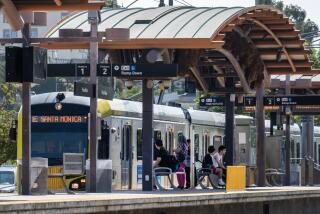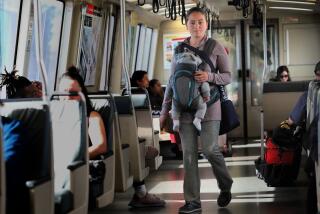Conejo Valley District Lowers School Bus Fees
Thousand Oaks school officials Thursday lowered fees that parents will have to pay next fall for their children to ride school buses, a move intended to boost ridership and raise enough money to cover busing costs.
Although busing has caused a smaller drain on school finances since the Conejo Valley Unified School District began charging for the service last fall, the program has fallen $140,000 short of the school board’s goal of making it self-sufficient.
“We could pay for several teachers with that,” board member Bill Henry said. “That’s a sizable chunk of money.”
By lowering the cost of a bus pass from $225 to $180 per semester, the district hopes to draw back hundreds of former bus-riding students who have found other ways to get to school since fees were imposed.
Since the fees were introduced, the number of riders has fallen by more than half, from 2,000 to 774 this semester, officials said. The district needed 1,100 students to buy passes at the $450 annual fee to break even.
With the lower fees, the buses will need 1,300 student riders to eliminate the deficit.
Henry said he wants monthly updates on the program’s financial status, and said parents should know that bus service could be eliminated at any time during the year if it is not solvent.
Board President Mildred Lynch said she was voting to continue busing despite her belief that transportation should not be a priority at a time when the district is cutting its budget for the fourth year in a row.
“My heart isn’t in it, but I’ll give it another go,” Lynch said.
The board could have chosen Thursday to eliminate busing for all students except those in special education, who must be transported by law.
But that would have created a hardship for working parents and increased transportation costs for field trips and out-of-town school sporting events, officials said.
At a board meeting last week, members asked Assistant Supt. Sarah Hart to provide information about how much the district’s costs would increase if home-to-school busing were discontinued. The district already spends $200,000 on special-education busing, and that cost would continue, Hart said.
On top of that, without a fleet of buses and drivers at the ready, the district would spend an additional $30,000 per year taking students on trips unless such excursions were limited, Hart said Thursday.
If a private bus were chartered or one were leased from another school district for sporting events, the average price per trip would shoot up 68%, Hart said. Parents of student athletes pay those costs with the help of booster clubs, Hart said.
Continuing to spend school dollars on busing students to and from school was not seriously considered, because the board is already faced with the need to cut $2.1 million from its $75-million budget for next school year.
Bus fee income has been down because more students than expected qualified for reduced or free fares, officials said. Under state law, districts that impose bus fees must provide free or reduced rates for needy children.
District administrators had estimated that 13% of the bus riders would qualify for the reduced or free rides, based on the number of students that receive reduced or free lunches under a federally sponsored program.
But more people applied for help in paying for bus passes than for lunches because of the large price tag for transportation, officials said. As a result, one-third of the riders qualified for reduced or free fares.
More to Read
Sign up for Essential California
The most important California stories and recommendations in your inbox every morning.
You may occasionally receive promotional content from the Los Angeles Times.










